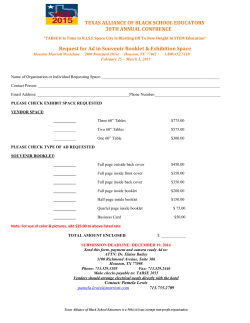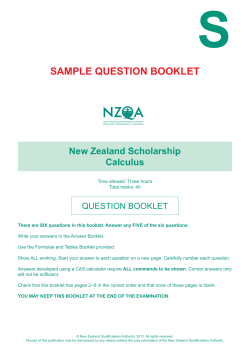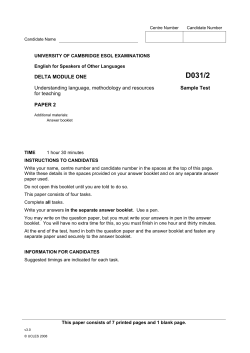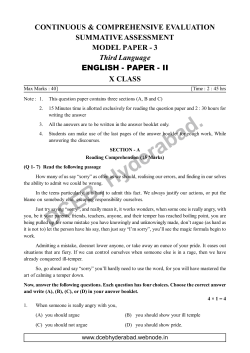
A sample of alcohol has the following four properties: 1
Question Booklet Page 1 PART A 1 A sample of alcohol has the following four properties: 1) It has a volume of 100 mL. 2) It does not conduct electricity. 3) Its temperature is 22°C. 4) It is flammable. Which of these are characteristic properties of alcohol? 2 A) 1 and 2 C) 2 and 4 B) 1 and 3 D) 3 and 4 Which one of the following statements about compounds is true? A) They are pure substances that form when two or more different atoms are combined. B) They are mixtures that can be separated only by physical means. C) They always consist of identical atoms. D) They always have the characteristics properties of the elements from which they were formed. Question Booklet 3 Page 2 The following four statements refer to Democritus' discontinuous model and Aristotle's continuous model. 1) Matter consists of tiny particles that cannot be divided. 2) Matter is made up of four elements (earth, water, fire and air). 3) Matter consists of separate particles. 4) Matter fills the entire space it occupies. Which of the above statements were made by Democritus? 4 A) 1 and 2 C) 2 and 4 B) 1 and 3 D) 3 and 4 The atomic mass of the first 18 elements of the periodic table increases as their atomic number increases. Which one of the following statements best explains this increase in mass? 5 A) Atomic mass depends most of all on the number of electrons and protons in each element. B) Atomic mass depends most of all on the number of electrons and neutrons in each element. C) Atomic mass depends most of all on the number of neutrons in each element. D) Atomic mass depends most of all on the number of neutrons and protons in each element. The following are changes undergone by different substances: 1) Salt dissolving in water 2) Sublimation of iodine 3) Oxidation of copper 4) Neutralization of an acid by a base Which of the above are physical changes? A) 1 and 2 C) 2 and 3 B) 1 and 4 D) 3 and 4 Question Booklet 6 Page 3 Two elements X and Y have the following properties. Element X Metallic lustre Two valence electrons Twenty neutrons Located in the 4th period Element Y Without metallic lustre Four valence electrons Six neutrons Conducts electricity Which symbols from the periodic table correspond to elements X and Y? 7 A) K and B C) Ca and C B) K and C D) Ca and B You are given an electromagnet and notice that its magnetic field is not strong enough. Which one of the following changes will increase the magnetic field strength of this electromagnet? A) Replacing the soft iron core with an aluminum core B) Increasing the current intensity C) Decreasing the number of turns D) Increasing the temperature Question Booklet 8 Page 4 Four electric circuit diagrams are given below. 1) 3) 2) 4) You wish to measure the potential difference across the terminals of resistor R2. Which diagrams show a correctly connected voltmeter? 9 A) 1 and 3 C) 2 and 3 B) 1 and 4 D) 2 and 4 The diagram on the right shows the main parts of an incandescent light bulb. Which of the substances used to make this light bulb are insulators? A) Copper and lead C) Plastic and glass B) Plastic and lead D) Glass and tungsten Question Booklet Page 5 10 The diagrams below illustrate a compass placed in magnetic field. 1) 3) 2) 4) Which diagrams show the compass needle pointing in the correct direction? A) 1 and 2 C) 2 and 3 B) 1 and 4 D) 3 and 4 11 The four electric circuits given below each consist of a power supply and resistors with different values. Which circuit has the lowest equivalent resistance? A) C) B) D) Question Booklet Page 6 12 A mystery circuit consists of two light bulbs (L1 and L2), a swith, and a power supply. The following table shows what happens to both light bulbs when the switch is opened or closed. Test Observations Open the switch L1 stays on Close the switch L2 goes out L1 stays on L2 comes on Which diagram correctly represents this mystery circuit? A) C) B) D) 13 During the summer, the 750-W electric motor of a swimming pool pump is used 24 hours a day for 100 days. Electricity costs $0.05/kWyh. How much does it cost to use this motor during the summer? A) $3.75 C) $90.00 B) $37.50 D) $90 000.00 Question Booklet Page 7 14 When a 3500-g block of lead was heated, its temperature increased from 20°C to 200°C. The specific heat capacity of lead is 0.13 J/(gy°C). How much heat energy was absorbed by this block of lead? A) 81.9 J C) 81 900 J B) 9 100 J D) 91 000 J 15 To check the electrical conductivity of certain substances, a student used a conductivity apparatus equipped with a light bulb. Her observations are listed in the following table. Substances Observations HCl Bright light CH3OH No light MgCl2 Faint light NaOH Bright light CH3COOH Faint light CCl4 No light Which one of the following groups of substances contains only electrolytes? A) CH3OH CCl4 C) CH3OH NaOH CH3COOH B) HCl MgCl2 CCl4 D) HCl MgCl2 NaOH CH3COOH BIM Question Booklet Page 8 16 The following table gives the pH value of four liquids. Liquid pH Tap water 6.8 Lemon juice 2.3 Human blood 7.3 Liquid bleach 11 Which one of these liquids is weakly acidic? A) Tap water C) Human blood B) Lemon juice D) Liquid bleach 17 Which one of the following substances is the major contributor to the greenhouse effect? A) Carbon dioxide (CO2) C) Nitrogen dioxide (NO2) B) Sulfur dioxide (SO2) D) Ozone (O3) 18 In the laboratory, you are asked to prepare 250 mL of a salt solution that will have a concentration of 24% (m/v). What mass of solute will you need? A) 6g C) 1 042 g B) 60 g D) 6 000 g BIM Question Booklet Page 9 19 Which one of the following equations is NOT balanced correctly? A) P4O10 + 6 H2O → 4 H3PO4 B) 2 F2 + 2 H2O → 4 HF + O2 C) 2 NaOH + H2SO4 → Na2SO4 + 2 H2O D) HCl + 2 NaHCO3 → 2 NaCl + 2 H2O + 2 CO2 PART B 20 In your answer booklet, draw a simplified atomic model (Bohr-Rutherford) for the potassium atom 39 19 K . 21 In a laboratory, you are given a liquid and asked to determine its density. 1. 2. 3. List the materials you would need. List the steps in the experiment you would perform in this case (procedure). Give an example of how you would calculate the density, using made-up data. 22 In the laboratory, you are given a power supply ( shown below. ), conducting wires and the six resistors Using the power supply and two of these resistors, you must build a parallel circuit that has an equivalent resistance of 100 Ω. Draw this parallel circuit in your answer booklet. BIM Question Booklet Page 10 23 The following electric circuit consists of a power supply, three resistors (R1, R2 and R3) and two A1 A2 and . ammeters The potential difference (VT) across the power supply is 15 V, ammeter A2 reads 0.2 A. ammeter The equivalent resistance (Req) of the circuit is 30 Ω. What is the value of resistor R3? Show all your work. A1 reads 0.05 A and Page 11 24 In the laboratory, you are given two acidic solutions. One has a pH value of 5, and the other has a pH value of 6.8. You are also given the following four indicators. 1) Methyl orange pH 1 2 3 Red 4 5 6 7 8 9 Orange 10 11 12 13 14 11 12 13 14 12 13 14 Yellow 2) Bromothymol blue pH 1 2 3 4 5 6 Yellow 7 8 9 10 Green Blue 3) Phenolphthalein pH 1 2 3 4 5 6 7 8 Colourless 9 10 11 Pink Dark pink 4) m-Cresol purple pH 1 2 3 4 5 6 7 Yellow 8 9 Brown 10 11 12 13 14 Violet Name the only indicator that would allow you to distinguish between the two solutions. State the colour of that indicator after it is added to each solution. 25 In the laboratory, a student was given a container with 150 mL of a solution of sodium hydroxide (NaOH) that had a concentration of 20 g/L. She added three 150-mL beakers of water to this solution. What was the concentration of the diluted solution? Show all your work. Page 12 4. CORRECTION KEY PART A Questions 1 to 19, 4 marks or 0 marks. 1 C 2 A 3 B 4 D 5 A 6 C 7 B 8 D 9 C 10 C 11 B 12 D 13 C 14 C 15 D 16 A 17 A 18 B 19 D Page 13 PART B Questions 20 to 25 20 Example of an appropriate diagram /4 or 21 Example of an appropriate procedure 1. Materials you would need: - Balance - Graduated cylinder 2. Steps in the experiment you would perform (procedure): - Weigh the empty graduated cylinder and record its mass. - Pour a certain amount of liquid into the graduated cylinder and record the volume of liquid. - Weigh the graduated cylinder when it contains the liquid and record its mass. 3. Example of how you would calculate the density, using made-up data: Mass of the cylinder: X Volume of the liquid: Y Mass of the cylinder when it contains the liquid: Z Z − X = mass of the liquid mass of the liquid = density Y /4 Page 14 22 Example of a parallel circuit /4 or 23 Example of an appropriate procedure Calculation of the total current It = VT 15 V = 0.5 A = 30 Ω Req Calculation of the current in R3 I3 = It – I1 – I2 I3 = 0.5 A – 0.05 A – 0.2 A I3 = 0.25 A Calculation of the voltage in V3 VT = V1 = V2 = V3 = 15 V Calculation of the resistance of R3 R3 = V3 15 V = 60 Ω = I3 0.25 A Answer The value of resistor R3 is 60 Ω. /4 Page 15 24 Example of an appropriate procedure Indicator: /4 2) Bromothymol blue Colour of that indicator after it is added to each solution: The indicator will turn yellow when added to the acid with a pH of 5. The indicator will turn green when added to the acid with a pH of 6.8. 4 marks 3 marks 2 marks 1 mark 0 marks Right indicator and correct colours Does not apply Does not apply Right indicator but the colours are incorrect or missing Wrong indicator regardless of the colours 25 Example of an appropriate procedure Since the volume increases from 150 mL to 600 mL (i.e. it is 4 times greater), the initial concentration will be divided by 4. 20 g/L ÷ 4 = 5 g/L A procedure involving the formula C1V1 = C2V2 is also acceptable. Answer The concentration of the diluted solution was 5 g/L. /4 Page 16
© Copyright 2025





















